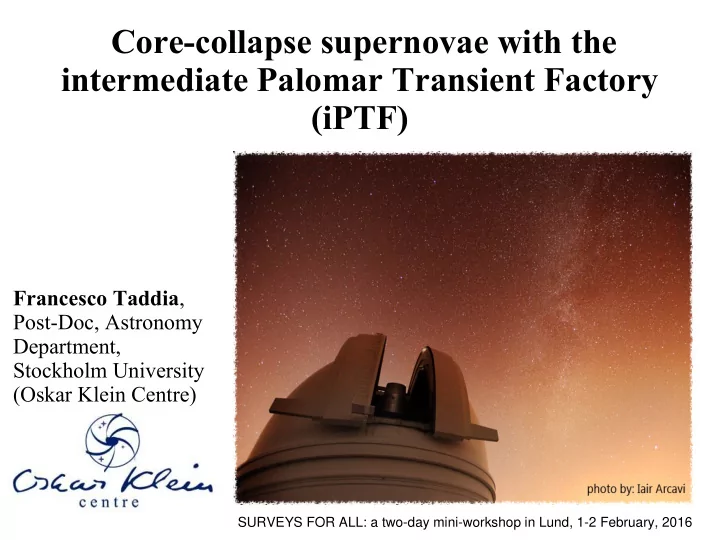

Core-collapse supernovae with the intermediate Palomar Transient Factory (iPTF) Francesco Taddia , Post-Doc, Astronomy Department, Stockholm University (Oskar Klein Centre) SURVEYS FOR ALL: a two-day mini-workshop in Lund, 1-2 February, 2016
Outline ● What is iPTF (and its continuation ZTF)? ● What do we want to learn from the core-collapse supernovae (SNe) found with iPTF? Investigating the connection between SNe and their massive progenitor stars. ● Which iPTF projects on core-collapse SNe are currently ongoing at the OKC?
The intermediate Palomar Transient Factory (iPTF) The intermediate Palomar Transient Factory (iPTF) is a fully-automated, wide-field survey Partecipants: aimed at a systematic exploration of the optical transient sky. It started in 2013 as a Caltech (PI: Shri Kulkarni) continuation of PTF (2009-2012). University of Wisconsin Los Alamos National Lab Oskar Klein Centre Weizmann Institute Kavli@Tokyo IUCAA + friends at LBL,Carnegie Palomar observatory P48
(i)PTF Searching the sky R-band sky coverage of PTF+iPTF, 2009-2015
IPTF Followup Marshal
OKC
What do we want to learn from studying core-collapse supernovae?
(i)PTF and core-collapse supernovae 1) (i)PTF found many CC-SNe (>700) of different types, allowing us to build large SN samples. 2) Many of them were found very early thanks to the high-cadence of (i)PTF . Gal-Yam et al. 2014, Nature 3) (i)PTF is an untargeted survey, CC SNe are found in different types of host galaxies.
Why is it important to find SN at early epochs? The flash spectroscopy method Hydrostatic surface (<10 12 cm) Opaque (optically thick) wind (up to ~10 13 cm) Gal-Yam et al. 2014, Nature Optically thin Wind, W-R emission lines
Why is it important to find SN at early epochs? The flash spectroscopy method Hydrostatic surface (<10 12 cm) Opaque (optically thick) wind (up to ~10 13 cm) Gal-Yam et al. 2014, Nature Optically thin Wind, W-R emission lines Nordic Optical Telescope
Which core-collapse supernovae are we mainly interested in? 1) Stripped-envelope core-collapse SNe : Type Ibc/IIb (Within iPTF we are responsible for the Type Ib/c). These supernovae lack hydrogen (sometimes even helium), which was stripped away from the progenitor star by either a companion star or strong winds. 2) Circumstellar-interacting supernovae (Type IIn, Ibn, Ia-CSM). These are supernovae whose ejecta interact with the material ejected by the progenitor system before collapse. 3) Other new or rare and peculiar SN events discovered by iPTF: e.g., 1987A-like supernovae. ------------------------------------------------------------------------------------------- We can study: a) Single objects; b) Large SN samples; c) SN environments. ------------------------------------------------------------------------------------------- Our goal: characterizing the properties of the SN explosion and of its progenitor star.
Stripped-envelope SNe PTF12os and iPTF13bvn Progenitor star in a binary system Fremling et al. 2016, to be submitted
Stripped-envelope SNe PTF12os and iPTF13bvn Progenitor star in a binary system Fremling et al. 2016, to be submitted
SN 2011dh/PTF11eon Ergon et al. 2014,2015
iPTF15cna, a slowly-evolving stripped-envelope SN Slow light-curve evolution as compared to other stripped-envelope SNe Karamehmetoglu et al. in prep.
iPTF15cna, a slow-evolving stripped-envelope SN Slow light-curve evolution as compared to other stripped-envelope SNe Single, massive Karamehmetoglu WR progenitor(?) et al. in prep.
The circumstellar-interacting SN IIn iPTF13z and its bumpy light-curve Nyholm et al. In prep.
The circumstellar-interacting SN IIn iPTF13z and its bumpy light-curve Nyholm et al. In prep. Luminous blue variable progenitor star (?)
SN IIn spectra from (i)PTF From spectral line analysis we can derive the CSM properties Roy et al. In prep.
SN IIn spectra from (i)PTF From spectral line analysis we can derive the CSM properties Luminous blue variable Roy et al. In prep. progenitor star (?)
Long-rising SNe II from PTF and CCCP Magnitudes Taddia et al. 2016, Days since explosion arXiv:1601.07368
Long-rising SNe II from PTF and CCCP Magnitudes Blue supergiant progenitor stars Taddia et al. 2016, Days since explosion arXiv:1601.07368
SNe Ic-BL from PTF/iPTF Taddia et al. In prep.
SNe Ic-BL from PTF/iPTF Energetic explosions of massive stars, sometimes associated with GRBs Taddia et al. In prep.
iPTF---->ZTF (Zwicky Transient Facility)
Conclusions 1) iPTF finds many core-collapse supernovae, at early epochs and in different host galaxy types. 2)We are interested to map the connection between CC SNe and their progenitor stars. We study single objects, SN samples and SN environments. 3) We are particularly interested in stripped-envelope SNe. These are coming from binaries and from massive single stars. Some of them are associated with GRBs. 4) We are studying CSM interacting SNe, likely arising from LBVs. 5) SNe similar to SN 1987A are coming from BSGs. 6) ZTF will give us higher cadence and sky coverage.
SN environments
iPTF13dqy
Recommend
More recommend